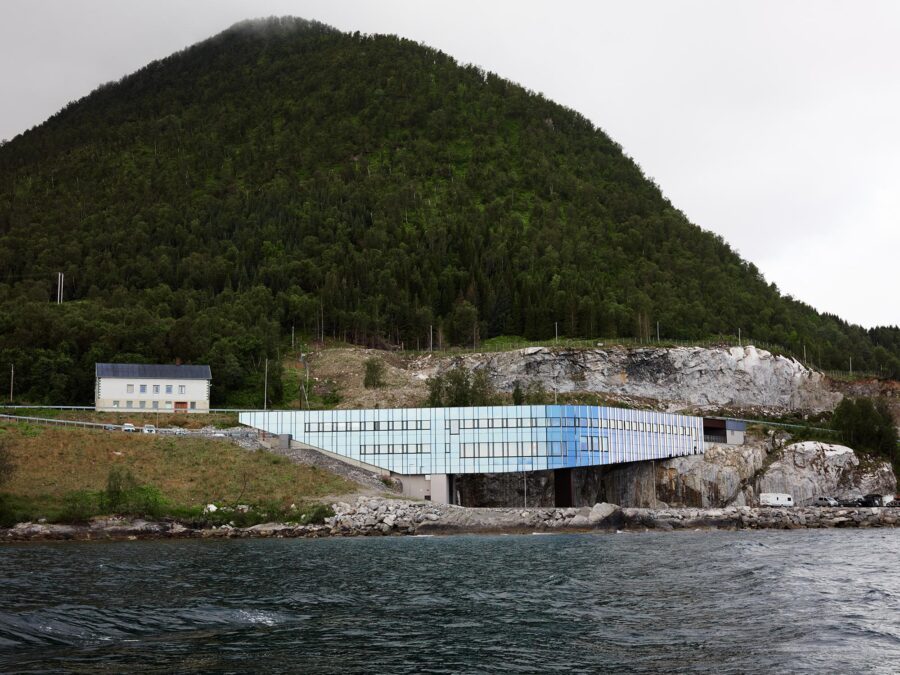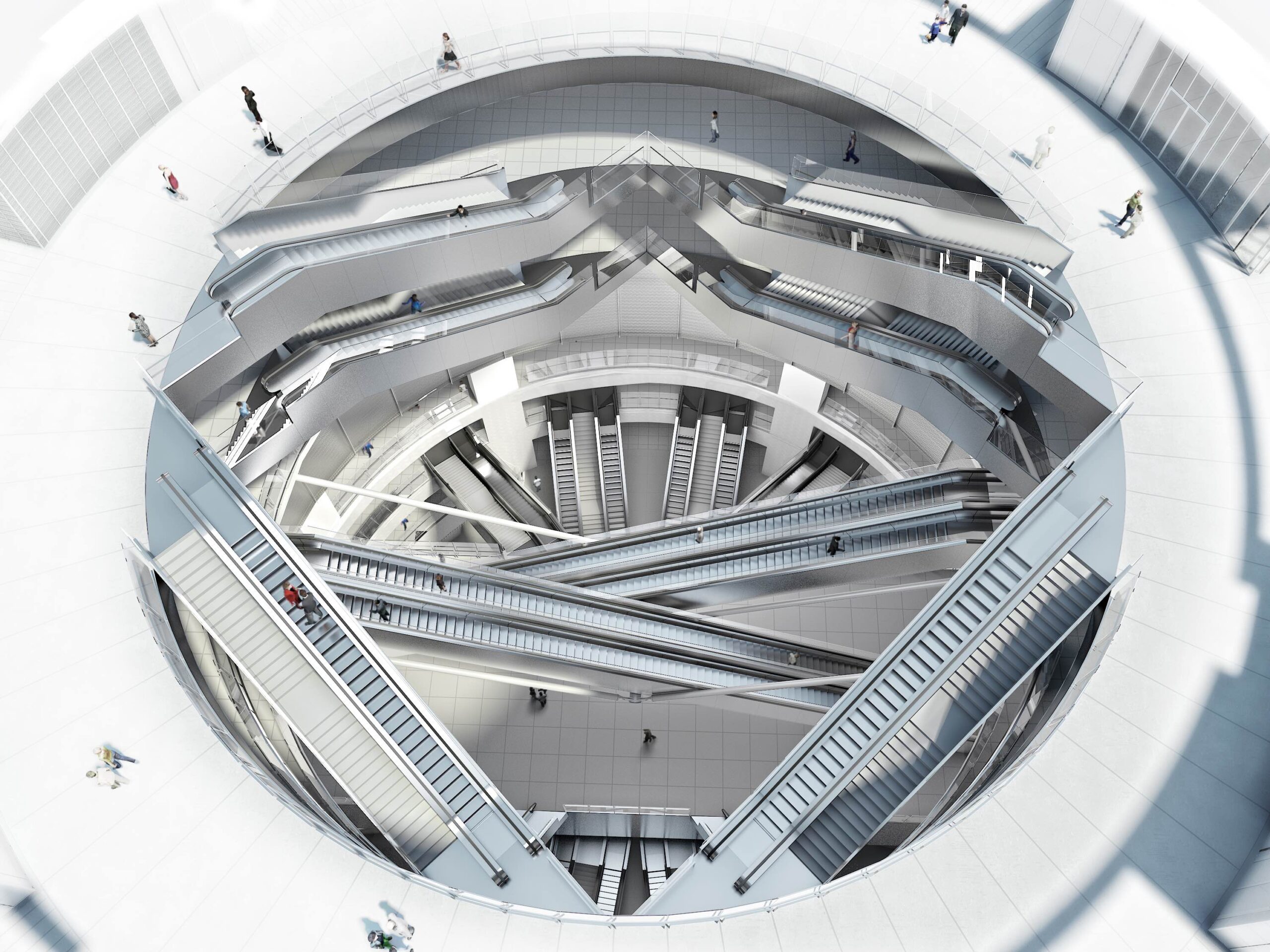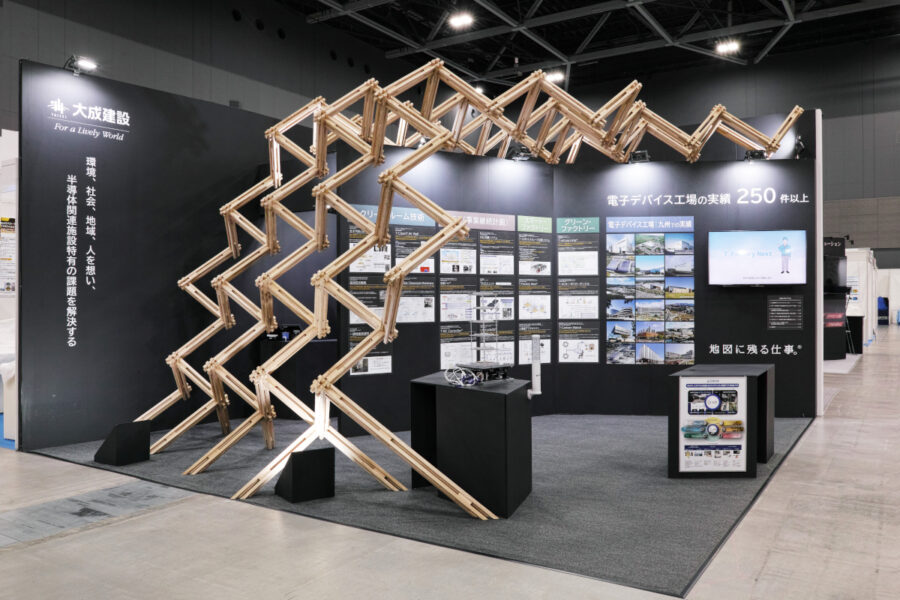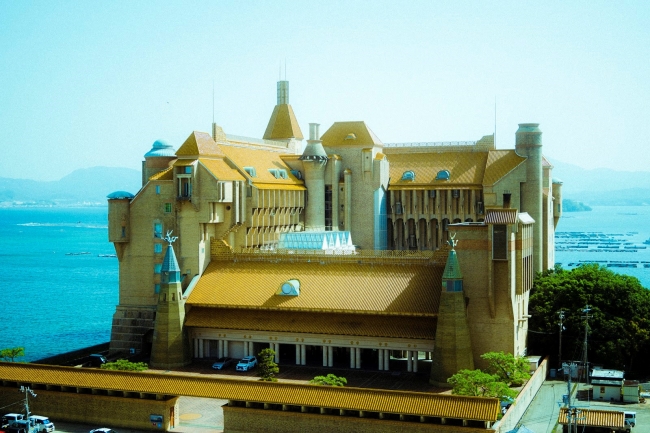
CULTURE


© Dominique Perrault Architecte, ADAGP
フランスの建築家・都市計画家 ドミニク・ペロー(Dominique Perrault)が設計した〈ヴィルジュイフ・ギュスターヴ=ルーシー駅(Villejuif-Gustave Roussy Station)〉は、単なる交通インフラという役目を超えた、鉄道と都市をつなぐよう設計されたフランス・パリ近郊の新たな地下鉄駅です。
ヨーロッパ最大級の都市開発プロジェクトである、68駅を新設する総延長200kmの「グラン・パリ・エクスプレス」の1つの駅として設計された建築です。
注目ポイント
- 都市との境界を曖昧にする、公共空間と駅空間の融合
- 50mの深さに自然光を取り込む地中に埋め込まれた建築
- 地下ならではの温度安定性でエネルギー消費を低減
- さまざまな質感のステンレスが演出する光に満ちた空間
- 地下の閉塞感を払拭し、快適で豊かな空間を提供
- 都市の移動をアートで変える、駅空間に組み込まれた現代美術
(以下、Dominique Perrault Architectureから提供されたプレスキットのテキストの抄訳)

© Dominique Perrault Architecte_ADAGP
〈ヴィルジュイフ・ギュスターヴ=ルーシー駅〉は、都市の境界を曖昧にすることで、公共のオープンスペースと駅の閉鎖的な空間との間の垣根を取り払うことを目指している。螺旋状の外観は、地下空間に都市全体を引き寄せる求心力を発揮している。
光に満ちた大きなコンクリートの円筒状の空間には、歩道橋やエスカレーターが縦断し、活気を与えている。自然光は、50m下のプラットフォームまで降り注ぎ、空は鉄道の上に広がっている。
ファサードの壁がなく、地中に埋め込まれたこの建築物は、都市やその他のものとは対立せず地平線を解放し、都市のシルエットから消え、空の一部を飲み込んでいる。

Sketch
パリとその近郊の都市体験を一新する「グラン・パリ・エクスプレス」
グラン・パリ・エクスプレス(Grand Paris Express)は、全長200kmを超える自動運転の路線と68の新しい駅を含む、ヨーロッパ最大の土木プロジェクトであり、新しい都市体験を求める人々の願いに応える、新しい都市の創造という地域プロジェクトである。
グラン・パリ・エクスプレスの目的は、地域に住むすべての人々が首都にアクセスできるようにすることだけではなく、首都圏全体にわたって生活と活動の新たなゾーンを開発することでもある。
グラン・パリ・エクスプレスの新駅周辺の地区開発は、その地域の都市化プログラムに内在する都市の課題であるとも言える。その範囲は、円周800mの円として定義され、パリ市域の1.5倍の面積に相当し、新首都圏の人口の20%以上を占めることになる。

© Source gallica.bnf.fr / BnF / Dominique Perrault Architecte, ADAGP
パリとその近郊を含む「グラン・パリ」が直面する課題とは何だろうか。
都市、郊外、農村地域のホスピタリティの向上、あらゆるタイプの空間的分離と疎外の是正、最も恵まれない市民をこれ以上苦しめることがないよう社会の多様性を促進、住宅と新しい居住形態の推進、移動性の最適化、都市中心部の接続強化、労働市場の活性化への貢献、そして最終的には、気候変動の課題に立ち向かう持続可能な大都市を実現することである。

© Cyrus Cornut_Société des grands projets_Dominique Perrault Architecte_ADAGP
ソシエテ・デ・グラン・プロジェ(Société des grands projets)は、フランスを代表する開発企業である。
2010年6月に当初はソシエテ・デュ・グラン・パリ(Société du Grand Paris)という名称で設立され、高速地下鉄「グラン・パリ・エクスプレス」の建設を管理し、駅周辺の都市開発や不動産プロジェクトを通じて大都市の変貌を支援している。

© Dominique Perrault Architecte, ADAGP
2030年までに200kmの自動運転地下鉄と68の駅を建設
グラン・パリ・エクスプレスは、200kmの地下鉄ネットワーク、68の駅の革新性、グラン・パリの140km²にわたる都市への影響、そして全線にわたる芸術的・文化的アプローチの野心的な取り組みという点において、ヨーロッパで最も重要な都市開発プロジェクトである。
グラン・パリ・エクスプレスに新設される68駅すべてと同様に、〈ヴィルジュイフ・ギュスターヴ=ルーシー駅〉も独自のユニークな建築デザインを採用している。

© Michel Denancé_Dominique Perrault Architecte_ADAGP
当初より、ソシエテ・デ・グラン・プロジェは、新設される各駅が単に機能的な枠組みを超え、その地域に都市および建築の遺産を残すことを目指しており、 すべての駅は著名な建築家とのコラボレーションにより設計されている。
ソシエテ・デ・グラン・プロジェの目的は、地域の都市および社会の変革に貢献する美的で実用的かつ快適な旅客施設を建設し、移動を可能な限り快適なものにすることにある。

© Michel Denancé_Dominique Perrault Architecte_ADAGP
パリの南側、ロンボワイヨ高原の最も高い位置にあるオット=ブリュイエール州立公園に位置する〈ヴィルジュイフ・ギュスターヴ=ルーシー駅〉は、地上とプラットフォームの間の深さが約50mあり、フランスで最も深い交通インフラの1つとなる。
セーヴル橋とノワジー・シャンを結ぶ15号線南線上に位置する〈ヴィルジュイフ・ギュスターヴ=ルーシー駅〉は、延伸された14号線との相互乗り入れを実現し、ZACキャンパス・グランパルクとヨーロッパ屈指のがん治療センターであるギュスターヴ=ルーシーを結び、2025年1月からは毎日10万人の乗客を迎えることになる。
グラン・パリ・エクスプレスの象徴的な駅となる〈ヴィルジュイフ・ギュスターヴ=ルーシー駅〉は、地域開発におけるインフラの役割と同様に、2つの地下鉄路線間の接続を確保するという役割も担っている。この未来の駅建築は、これらの空間を対話させ、統合し、団結させるというプロジェクトの決意を表している。

© Michel Denancé_Dominique Perrault Architecte_ADAGP
鉄道と都市をつなぐプロジェクト
広場レベルでは、前庭は自然に中央の吹き抜けを見下ろすバルコニーへとつながっており、小さなキオスクにはさまざまなサービスが用意され、駅の周辺を彩る。
金属メッシュで覆われた壁は駅の閉鎖を可能にしており、これらの要素は都市と公園の眺望を遮らない軽やかな境界線となっている。
地下2階までは切符なしでも利用できるオープンアクセスとなっており、バルコニーギャラリーの最初の2つのレベルには店舗やサービス施設が配置され、駅と地上の公共スペースの連続性を強調している。

© Michel Denancé_Dominique Perrault Architecte_ADAGP
このプロジェクトは、利用者が駅の空間と動線を容易に把握できるよう計画されている。
プラットフォームから出ると広大な中央の吹き抜けに直接つながり、利用者は方向感覚を取り戻すことができる。2つの地下鉄路線が垂直方向に重なり合う2層のプラットフォームからは、自然光に導かれるように、記念碑的なエスカレーターが地上へと続いている。

© Dominique Perrault Architecte_ADAGP

© Dominique Perrault Architecte_ADAGP
自然の光と空気に満たされた開放的な地下鉄駅
この駅は自然光と通気性に恵まれている。プラットフォームと直接つながった広大な中央の吹き抜けとさまざまなバルコニーの通路は、自然光と外気に満ちている。
この原則により、このインフラストラクチャの優れた機能の1つである、中央部分に排煙設備を必要としないことが可能になっている。また、この深さにより地上よりも気温が穏やかになり、暖房設備に頼る必要もない。

© Dominique Perrault Architecte_ADAGP
存在感を示しつつも都市に溶け込む透明な円形屋根
駅の屋根は3層構造になっている。中央の透明な円形の屋根は、外気を循環させながら雨を防ぐ。この屋根は、すべてのタイロッドとケーブルが中央ハブに連結された1本の梁で構成されている。ケーブルには、透明性、軽さ、耐久性、そして非常に細いという優れた特性をもつETFE製の部材が張られている。
中心の異なる2つの円盤状の屋根が、異なる高さで駅を覆っている。2つの巨大なテントのように駅前広場に広がり、駅の存在を知らせると同時に、公共スペースに設置された日よけのように、利用者を日差しから保護する。これらの屋根は放射状の垂木の間に張られた螺旋状の金属メッシュの帯から構成されている。

Model © André Morin_Dominique Perrault Architecte_ADAGP
レジリエンスとサステナビリティ
「レジリエンス」は現代における重要なキーワードである。地球規模の気候変動に直面する人類社会の未来を予測、適応、耐える、反応する、生き延びるといったキーワードであるとともに、システムを構築できるプログラミング用語でもある。
構造にはコンクリート、外装にはガラスとステンレススチールを採用したこの駅は、堅牢性と耐久性を備えたものとなっている。全体的な構成は最小限であり、すべての要素には構造上または技術上の機能をもたせている。
地下における利用可能な天然資源を活用することで、駅は環境に可能な限り繊細に統合されている。周囲の土壌を利用して温度を一定に保つことができるため、暖房、空調、排煙設備を追加する必要がなくなり、大幅なコスト削減、持続可能性、利用者の快適性が確保されている。

© Michel Denancé_Dominique Perrault Architecte_ADAGP
「地下世界」のイメージの対極にある快適で豊かな体験を提供する空間
地下の世界は、しばしば不快、寒さ、神秘、不明瞭さを表す同義語として扱われる。一方で、地下深くに位置しながらも光と空気を採り入れることができるこの駅は、利用者にその対極にある体験を提供する。
利用者がこの空間に入ると、地下はもはや不安を煽るような閉鎖的で湿気のある場所ではなく、快適で五感を刺激する体験を提供してくれる場所であることが理解することができる。

© Michel Denancé_Dominique Perrault Architecte_ADAGP
中央の吹き抜けは、乗り換え客がこの施設内で起こっている出来事と触れ合うことができる機会を提供している。公共スペースと駅を融合させることで、このプロジェクトは完全に公共の施設となっている。この意味において、駅は都市の延長であり、地上でも地下でも同じ雰囲気を感じることができる。
駅はもはや単なる交通インフラや移動の場ではなく、活気のある交流の場となり、利用者に単にサービスが集中しているだけではなく、動線と公共スペースの間に新しい都市生活の形を提供している、交通機関以上の用途をホストできる資質を備えた場所となる。

© Michel Denancé_Dominique Perrault Architecte_ADAGP

© Arthur Jan_Dominique Perrault Architecte_ADAGP
さまざまな質感のステンレスが表現する光に満ちた空間
ドミニク・ペロー建築事務所の共同経営者であるガエル・ロリオ=プレヴォ(Gaëlle Lauriot-Prévost)が、内装レイアウト、照明、音響効果を設計した。このプロジェクトでは、滑らかな表面、メッシュ、穴あき、鏡面仕上げ、サテン仕上げなど、さまざまな質感のステンレススチールが使用されている。
これらの仕上げにより、さまざまな雰囲気をつくり出すと同時に、反射、輝き、フィルター効果により光の伝播を促す。

© Dominique Perrault Architecte_ADAGP
螺旋状のステンレスメッシュの帯で構成された表面積3,273m²の円盤が、放射状の梁に張られ、外側の屋根を構成している。内部では、1,808m²の銀色のアルミニウムワイヤーが大きな井戸のような空間を覆い、駅構内の中心部を彩っている。
もともと工業製品であり、冷たく硬いものと見なされていた金属メッシュに、新たな機能が与えられた。壁でも構造物でもない金属メッシュは、保護という概念を再考するために使用され、音響効果を生み出し、ボリュームを消し去り、照明と反射の遊びを導入している。
天井には照明器具と音響バッフルボードが交互に並び、駅に規則正しいリズムを与えている。工業用照明器具からの光が自然光と混ざり合い、表面の凹凸で反射し、利用者は光のショーに包み込まれる。

© Dominique Perrault Architecte_ADAGP
新たな駅への現代美術の導入
ソシエテ・デ・グラン・プロジェはプロジェクトの早い段階で、68の新しい駅の空間と建築に現代美術を取り入れるため、予算の1000分の1にあたる3500万ユーロを充てることを決定した。
これらの駅は、本格的な生活空間および発見の場として設計されており、交通機関の乗車券で誰もが利用できる巨大な美術館なのである。

© Dominique Perrault Architecte_ADAGP
地下に広がる「天空のヴォールト天井」
「駅舎の内部空間を隔てる境界線を、無限の建築的志向性へと進化させる。」
これが、〈ヴィルジュイフ・ギュスターヴ=ルーシー駅〉の中心部にチリのアーティストであるイバン・ナバーロ氏(Ivan Navarro)がデザインしたプロジェクトの野望であった。
アーティストは天文学者となり、そして魔法使いにもなり、地下9階の円形天井の場所に、ネオン管と鏡で覆われた空を表現し、無限の深さの感覚を生み出した。その作品は、58個のライトボックスに刻まれた星の名前によって構成されている。この作品は、すべての乗客に宇宙的な視覚体験を提供する。

© Michel Denancé_Dominique Perrault Architecte_ADAGP_2019

© Michel Denancé_Dominique Perrault Architecte_ADAGP_2019

© Michel Denancé_Dominique Perrault Architecte_ADAGP_2021

© Michel Denancé_Dominique Perrault Architecte_ADAGP_2021

© Michel Denancé_Dominique Perrault Architecte_ADAGP_2021

© Michel Denancé_Dominique Perrault Architecte_ADAGP_2021

© Arthur Jan_Dominique Perrault Architecte_ADAGP_2023

© Arthur Jan_Dominique Perrault Architecte_ADAGP_2023

Model © André Morin_Dominique Perrault Architecte_ADAGP

Model © André Morin_Dominique Perrault Architecte_ADAGP
以下、Dominique Perrault Architectureのリリース(英文)です。
VILLEJUIF – GUSTAVE ROUSSY STATION
VILLEJUIF, FRANCEThe Villejuif-Gustave Roussy Station aims to erase the threshold between the open public space and the closed space of the station by blurring the limits of the city. Its helicoidal architecture on the surface exerts a centripetal force on the urban fabric which draws it towards the space that has been competed underground. The large concrete cylinder with its moulded wall, flooded with light, is traversed, and enlivened by footbridges and escalators. Here, the sky of this inverted skyscraper is simply the ground level of the city. Natural light pours all the way down to the platforms located some fifty meters below. The sky is above the railways.
This exposed infrastructure is given maximum visibility and incorporates the logic of construction. The architectural layout is part of the urban cityscape. By erasing in the ground and prolonging uses and views between the surface and the subterranean domain, it unifies the vertical dynamics of access to the transport network. The architectural treatment transfigures this infrastructure now become architecture.
Without walls of façade, the architecture of this station sunken into the ground is not in opposition to the city or anything else. It frees the horizon and disappears from the urban silhouette, swallowing up with it then bit of sky.
Dominique Perrault, 2024
Superposition of the Grand Paris Express onto the map of the APUR and the 68 new station neighbourhoods. © Dominique Perrault Architecte / ADAGP
The Groundscape and the territory
by Dominique PerraultToday, the Grand Paris Express is the largest project of civil engineering in Europe including over 200 km of automated lines and 68 new stations. It involves first and foremost a territorial project and the making of a new city in sync with the collective aspirations for a new urban experience. The Grand Paris Express is a major piece of this major bet of the metropolis.
A new territory is taking shape before our eyes, made available to the greatest number. The objective is not merely to ensure access to the capital to all inhabitants of the region but also to develop new zones of live and activity across the entire metropolitan region. The development of the districts surrounding the new stations of the Grand Paris Express is, in that sense, a challenge of urbanity inherent to the territory’s programme of metropolization. Their perimeters, defined as a circle of 800m of circumference, will represent nothing less than one and a half times the size of Paris proper and more than twenty percent of the population of the new metropolis.
What are the challenges facing Grand Paris? Increasing the hospitality of cities, exurban and rural zones, rectifying spatial segregation and relegation of every type, encouraging social diversity without further weakening the most disadvantaged citizens, promote housing and new modes of habitat, optimise mobility, intensify the connexions between urban centres, contribute to the boosting labour markets, and, finally, to the emergence of the sustainable metropolis facing the challenge of climate change.
The Société des grands projets is one of France’s leading project developers. It was created in June 2010, initially under the name Société du Grand Paris, to manage the construction of the Grand Paris Express and support the transformation of the metropolis through urban development and real estate projects around the stations.
200 km of automated metro and 68 stations by 2030
The Grand Paris Express is the most important urban development project in Europe, in terms of the breadth of its future network of 200 km of metro, the innovation of its 68 stations, the urban impact of its 140 km2 across the territories of Grand Paris, and the ambition f its artistic and cultural approach along its entire length.Like all 68 new stations on the Grand Paris Express, the Villejuif – Gustave Roussy station has its own unique architecture. From the outset, the Société des grands projets wanted each of the new stations to go beyond its functional framework, leaving an urban and architectural legacy for the area it serves. All the stations have been designed in collaboration with renowned architects, making some of them among the most aesthetically pleasing in the world.
The aim of Société des grands projets is to make travel as pleasant as possible, with aesthetic, practical and comfortable passenger buildings that contribute to the urban and social transformation of the territory.
A project for transforming the city
Line 14 is extended to the north and south of Paris4 new automated metro lines
serving the inner and outer rings of suburbs68 stations
all accessible, designed for the comfort of passengers and open to the city80% of the stations
connected to the existing network: Metro, RER, Transilien, and Tramway2 to 3 mn
between each train, with an average speed of between 55 and 65 km/h3 million voyagers
transported each day. The Grand Paris Express will relieve the pressure on the existing network.Studies begin: 2013
Works begin: April 2017
Completion: December 2024Client: Société des grands projets (SGP)
Engineering project management: SETEC
AMO: Artemis (groupement Artelia + Arcadis + BG)
Project Management: Dominique Perrault Architect
Engineering: SETEC TPI (civil engineering), SETEC bâtiment (construction engineering), Ingérop (coordination, interfaces), TESS (special structure, façades, roofing ETFE), AXIO (economist), Jean-Paul Lamoureux (acoustics and photometrics), Denis Thélot (fire safety and accessibility)
Entreprises: Groupement CAP (Vinci construction, Spie Batignolles), Systra, Artelia, Bouygues bâtiment IDF, AXIMA, INEOSite surface area: 7,500 m²
Project surface area: 15,364 m²
Built volume: 203,771 m³Well diameter: 70 m
Depth of moulded walls: 42 m
Depth of line 15 South platforms: 49 m
Depth of line 14 South platforms: 37 m
Number of escalators: 32A metropolitan station
Located on the highest point of the Longboyau Plateau, in the departmental park of the Hautes Bruyères, the Villejuif-Gustave Roussy Station, with a depth of some 50 metres separating the street level from the one of the platforms, will be one of the deepest transport infrastructures in France.Located on the line 15 South, which links Pont de Sèvres with Noisy-Champs, the future Villejuif Institut Gustave-Roussy will create the interconnexion with the extended line 14 and will welcome some 100,000 passengers every day from January 2025. It will serve the ZAC Campus Grand Parc and the Institut Gustave-Roussy, the leading cancer treatment centre in Europe.
An emblematic station of the Réseau du Grand Paris Express, owing as much to the role of infrastructure in developing the territory, as to the interconnexion it will ensure between two metro lines, the architecture for the future station expresses the determination of the project to place in dialogue, unite, and federate these spaces.
“A station as connector if he world above and below.”
Dominique PerraultConnecting the Gustave Roussy Hospital with the larger network
On the level of the square, the forecourt leads naturally towards the first balcony overlooking the central void. Little kiosks house a range of services and punctuate the periphery of the station. Walls draped with metal mesh enable the closure of the station. These elements are a light form of limit offing view onto the city and the park.Open access (i.e., without a ticket) is possible down to level -2. The first two levels of balcony galleries house shops and services, accentuating the continuity of the station with the public space above.
The project facilitates easy comprehension of the space and the circulations. When leaving the platforms, directly linked to the vast central void, users easily find their bearings and directions. From the two levels of platforms – the two metro lines being located in two perpendicularly superimposed tunnels – monumental escalators lead to the surface, guided by natural light.
An open-air station
The station benefits from natural light and ventilation. In direct contact with the platforms, the vast central void and the various balcony circulations are bathed in natural light and open air. This principle is what makes one of the forms of prowess of this infrastructure possible, i.e., the one of eliminating the need for smoke extractors in its central part (the well). Travellers will also be in contact with the ambient temperature, which is more temperate at this depth than on the surface, without reliance on additional heating.The roof over the station is composed of three layers. A centrale transparent circular one protects from rain while allowing outside air to circulate laterally. This roof consists of a one peripheral beam on which all the tie rods and cables are linked with the central hub, the “eye” of the station. Stretched over the cables are elements made of ETFE (ethylene tetrafluoroethylene), the material chosen for its high quality of transparency, lightness, resistance, and its great fineness. Two other roofs, non -concentric disks placed at two different heights, cover the station. Like two great marquees, they radiate over the forecourt and signal the presence of the station whilst also ensuring user protection from the sun, like sunshades over the public space. They are composed of strips of stainless-steel spiralled metal mesh, stretched between the radial rafters.
Resilience
Resilience is a word of our times. A programming word, capable of creating a system given that it predicts the future of human societies facing planet-wide climatic shock, along with these watch words: assimilate, endure, react, subsist.By resilience, one designates the ability of materials to resist forces of rupture and weather. By choosing concrete for the structure and glass and stainless steel for cladding, the station is anchored in the determination of solidity and durability. The overall composition is minimal and all the elements have a function, whether structural or technical. By employing natural resources available underground, the station is as delicately integrated as possible in its environment, which enables, among other advantages, to insulate the interior from the exterior earth and to maintain a constant temperature by using the surrounding earth, thereby eliminating the need for additional heating, air-conditioning, or smoke extraction. This ensures important cost savings, sustainability, and comfort of users.
“In the metropolis crossed by the Grand Paris Express, is reflected in a new light, the ancient image of the great city-world, resilient and sustainable.”
Dominique PerraultThe “sous-terrestre”
The world underground is often synonymous with discomfort, cold, mystery, and obscurity. The station being anchored in the deep whilst allowing light and air to pour in, it offers users the opposite experience. As users penetrate this space, they understand that the ground is no longer anxiety-provoking, closed, and damp, but rather that it offers comfort and an experience engaging all the senses. The central well makes it possible to gather in the heart of this innovative facility all travellers who, though in transit, are in contact with what is happening inside. By confusing the public space and the station, the project transgresses the traditional terminology of buried works to become a fully public facility. It is in this sense that the station is the extension of the city in that we encounter the same ambiance whether we are above or below.The station is no longer merely a work of transport infrastructure, and a place of circulation, but now it has become a lively place of exchange offering users, beyond simply a concentration of services, new forms of urban living, between individual pathways and the public space. Places in the fullest sense of the term, endowed with qualities, able to host uses that exceed transport.
Materiality, light, acoustics
Gaëlle Lauriot-Prévost, an associate of the Dominique Perrault Architecture firm, designed the interior layouts, lighting and acoustics. The materiality of the project makes use of stainless steel in a range of textures: smooth, mesh, perforated, mirror polish, and satiny. These finishings create different ambiances, whilst also favouring the propagation of light, through the play of reflections, brilliances, and filters.Des disks with a surface area of 3,273 m², composed of swaths of spiralled stainless-steel mesh, stretched between radial beams, structure the exterior roof. Inside, 1,808 m² of silvery aluminium wire clad the great well, thus electrifying the heart of the station. Originally an industrial product, previously considered as cold and rigid, metal mesh is assigned a new function: neither wall nor structure, it is used to rethink the notion of protection, and acoustics, dematerialize volumes, introduce the play with lighting and reflection, and to clad here and there the station and its facilities.
On the ceiling, light fixtures and acoustic baffles alternate, giving the station a regular rhythm. Light from the industrial light fixtures blends with daylight and is reflected by the meatal surfaces, immersing travellers in a genuine light show.
“In Villejuif, the lines are blurred by the superposition of woven elements: the strips of fabric woven together are themselves woven material. The effect of undulation functions as it does because there is always a strip to shine. At night, the lighting effects enhance safety and the aesthetic value of the space. In the barrel, woven sheets reaching a height of fourteen metres ensure calmer acoustics. Light slips through them down to the deepest areas of the station.”
Gaëlle Lauriot-Prévost, on metal mesh, 2024Artistic commission
The Société des Grands Projets early on decided to dedicate one per one thousand of its budgetary resources, some thirty-five million euros, for the inclusion of contemporary art in the spaces and the architecture of the 68 new stations, designed as full-fledged living areas and places of discovery. A vast museum visited by everyone visits with a transport ticket.A subterranean Vault of Heaven
“Evolve the frontiers that separate interior spaces of the station towards infinite architectural orientations.” Such was the ambition of the Chilean artist Ivan Navarro for his project in the heart of the Villejuif station. The artist became an astronomer – and a bit of magician – to cause to appear, in the location of the circular ceiling of level -9 a sky studded with neon tubes and mirrors, creating the sensation of infinite depth. The names of stars have been engraved on the 58 light boxes of which it is composed. This work offers a cosmic visual experience to all passengers.Cadran solaire by Ivan Navarro
Ceiling Level -9, LED tubes, mirrors made of Dibond without silvering, aluminium, sand-covered lettering, 58 trapezoidal boxes 1.9 m long, 39 cm and 43 cm wide and 30 cm in height.KEY FACTS AND FIGURES
An emblematic project of the Grand Paris Express
– One of the 68 new stations of the Grand Paris Express, one of Europe’s largest urban projects, 200km of automatic lines.
– Goal: to give reality to the Greater Paris metropolis through mobility and the blurring of boundaries between the city-center and its suburbs.Innovative architecture
– Designed by Dominique Perrault, the station, located 50m underground, links the city to its subsoil, creating functional and visual continuity. Architecture merges city and infrastructure.
– Sleek design: no walls or facades, a vast cylindrical central shaft bathed in natural light thanks to a transparent double roof and reflective materials.Territory impact
– A place to live: integration of public spaces, shops and services on the first two levels.
– Located in the ZAC Campus Grand Parc, it will link the Institut Gustave Roussy hospital network, the park and the new district.
– A vector of development for the surrounding neighborhoods, integrating social diversity and new employment pools.Sustainability
– Resilience and energy efficiency: natural smoke extraction (excluding technical areas), reduced heating and cooling requirements thanks to natural underground resources.
– Resistant materials: concrete, stainless steel, glass and wire mesh.Contemporary art
– In “Tandem”, Chilean artist Ivan Navarro has designed Cadran solaire, a starry sky of neon lights and mirrors.
– Goal: to make the Grand Paris Express network a museum accessible to all.Important dates
Studies begin: 2013
Works begin: April 2017
Completion: December 2024
Commissioning of line 14: 2025
Commissioning of line 15: 2026Key figures
Project surface area: 15,364 m²
Built volume: 203,771 m³
Depth of line 15 South platforms 49 m
Depth of line 14 South platforms 37 m
Expected capacity 100,000 daily voyagers
Dominique Perrault Architecture 公式サイト
https://www.perraultarchitecture.com/en/homepage/









